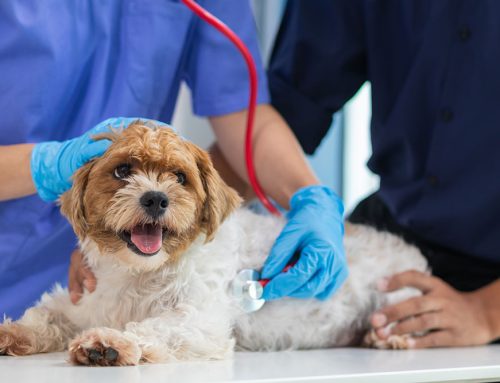Nonstop scratching, head tilting, and an unmistakable odor—after helping your pet battle a few ear infections, you likely recognize the signs. Unfortunately, if an ear infection’s underlying cause is not addressed, the condition continues to return—often immediately after your pet has completed treatment for the previous infection.
Chronic ear infections are a miserable and frustrating condition that requires thorough veterinary investigation and diligent at-home care. If your pet suffers from ongoing ear problems, our Liberty Veterinary Hospital team can help by determining the infection’s source.
Why do pets develop chronic ear infections?
Ear infections’ hows and whys are important to understand. Your pet’s initial ear infection—which may have been months or years ago—most likely stemmed from an underlying (i.e., primary) condition such as:
- Ear mites
- Allergies
- Skin or glandular disorders
- Foreign objects (e.g., seed or grass awn), hair, or water in the ear canal
- Tumor, mass, or obstruction
- Autoimmune or endocrine disorders
Underlying infection causes alter the ear canal environment by creating inflammation or moisture, or preventing adequate air flow. Such disruptions allow secondary causes—such as bacteria or yeast—to take hold and multiply, resulting in the recognizable itch, odor, and discharge that typically accompany pets’ ear infections.
When ear infection treatment addresses only the secondary infection cause—bacteria or yeast—the primary cause often remains. In addition, although ear medication appears initially successful—because the ear drops or drug relieves your pet’s discomfort and reduces the bacteria or yeast population—the infection inevitably returns after treatment is complete. For effective and long-lasting resolution, treatment must address an ear infection’s primary condition.
Are some pets prone to chronic ear infections?
Although all pets can develop ear infections, some physical features and activities can predispose them to problems. Risk factors include:
- Narrow ear canals
- Long or droopy ears (e.g., hounds, spaniels, retrievers)
- Ear canal hair
- Frequent swimming or bathing
- Known allergies
How can I tell if my pet has an ear infection?

You are likely familiar with your pet’s ear infection signs. However, these signs may vary based on the infection’s cause or severity, and can include:
- Frequent head scratching
- Head shaking and rubbing
- Painful ears
- Ear odor
- Head tilt
- Visible inflammation or discharge
- Head-shy behavior
- Behavior changes (e.g., irritability, lethargy)
- Thickened ear tissue
Chronic infections create a vicious inflammation-infection cycle. With each infection, the irritated ear canal tissue swells and thickens (i.e., hyperplasia). This thick and misshapen tissue narrows the ear canal further, making infections more difficult to prevent and treat.
How are chronic ear infections diagnosed in pets?
If your pet displays ear infection signs, do not wait to get them veterinary care. Pets who have ear infections can experience severe pain. If your pet experiences ongoing ear issues, our Liberty Veterinary Hospital veterinarians will perform a standard comprehensive physical examination, and an ear-specific assessment, which includes:
- Ear exam — Your veterinarian examines your pet’s outer and inner ear, conducting a visual assessment of the ear flap (i.e., pinna) and external ear canal. In addition, your veterinarian performs an otoscopic examination to observe your pet’s eardrum (i.e., tympanic membrane) and looks for obstructions such as dermal masses or foreign objects. If your pet’s ear is sensitive, painful, or packed with debris, your veterinarian may recommend sedation to reduce your dog’s or cat’s discomfort and stress during the ear exam.
- Ear swab — Your veterinarian will gently take a swab of any debris or discharge for microscopic analysis.
- Ear cytology — Your veterinarian will perform a microscopic analysis of your pet’s ear swab, looking for bacteria, yeast, parasitic organisms, abnormal cells, and inflammation.
- Deep ear flush — If your pet has heavy ear discharge or copious debris, your veterinarian may do a deep ear cleaning—while your dog or cat is sedated—to ensure they can complete a thorough examination.
Depending on your veterinarian’s findings, they may recommend additional testing—possibly with a veterinary specialist—to isolate and diagnose the primary cause of your pet’s ear infection. Follow-up testing includes:
- Blood work — If your veterinarian suspects your pet has an underlying health problem, they may perform blood work to assess your dog’s or cat’s endocrine and immune function.
- Advanced imaging — Your veterinarian may recommend your pet have a computed tomography (CT) scan or a magnetic resonance imaging (MRI) scan.
- Allergy testing — To determine the specific allergens that inflame your pet’s immune system, your veterinarian may conduct intradermal (i.e., skin) testing, ensuring they target your dog’s or cat’s chronic ear infection treatment to the appropriate primary condition.
How are chronic ear infections treated in pets?
Determining your pet’s primary ear infection cause may become a process of elimination—especially if you decline recommended advanced testing. However, your veterinarian may still be able to provide your pet with effective pain relief, and resolve their chronic issues. Pets’ ear infection treatment varies greatly depending on the diagnosis, but may include:
- Medication — Topical or oral medication is often prescribed to reduce inflammation, as well as an ear medication (i.e., antibiotic or antifungal) to eliminate bacteria and yeast. Condition-specific medications manage allergies, autoimmune disorders, and endocrine abnormalities, or eradicate ear mites.
- Cleaning — To improve air flow and expedite healing, thorough ear cleaning removes debris, discharge, and trapped hair.
- Diet change — If your veterinarian suspects your pet has a food allergy, they will suggest a hypoallergenic or limited-ingredient diet to prevent flare-ups.
- Immunotherapy (i.e., allergy shots) — Customized injections can reduce your pet’s sensitivity to environmental allergens, and prevent unwanted inflammatory reactions that contribute to ear infections.
- Surgery — Surgery may be necessary to remove an obstructive tumor or an irritating foreign body. If chronic infection has severely damaged your pet’s ears, they may be a candidate for total ear canal ablation (i.e., [TECA] surgical removal of the ear canal). Although radical, this procedure is often the only treatment that eliminates your pet’s pain and suffering, restoring their quality of life (QOL).
Pets’ chronic ear infection management begins with an accurate diagnosis and targeted treatment. As an American Animal Hospital Association (AAHA)-accredited practice, our Liberty Veterinary Hospital team is committed to delivering the most comprehensive and advanced veterinary care to help your pet live a long and healthy life. Schedule an appointment so we can provide your pet effective relief for their chronic ear infections.








Leave A Comment